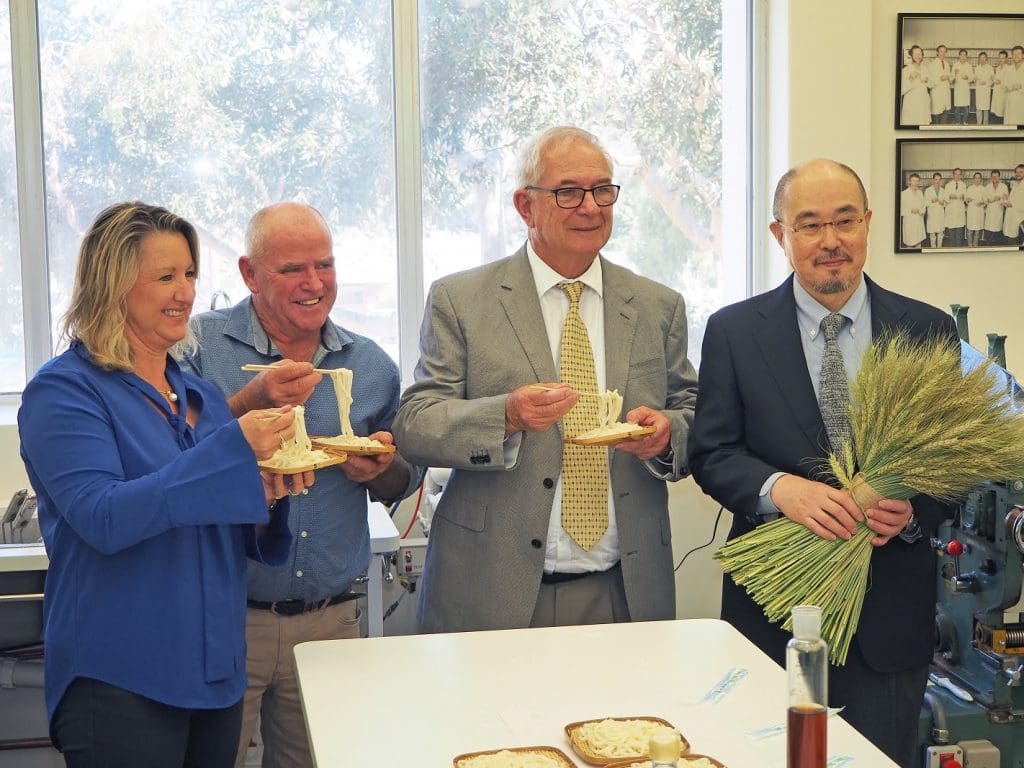
WA noodle wheat growers Steph and Barry Clarke (Bolgart), former WA Department of Agriculture scientist Dr Graham Crosbie, and Shunsuke Otsubo (the second visiting Japanese noodle expert – 1991).
THE official 2019 udon noodle sensory evaluation program is underway at the Australian Export Grains Innovation Centre (AEGIC), as Western Australia and Japan celebrate the 30-year anniversary of the unique noodle wheat segregation.
Since 1989, 13 highly-trained Japanese noodle specialists have visited Australia to help assess unreleased wheat varieties that have been purpose-bred for Japanese udon noodles.
AEGIC Wheat Quality Technical Markets manager Dr Larisa Cato said sensory evaluation was a core pillar of the special noodle relationship between Western Australia and Japan.
“AEGIC runs the sensory program in collaboration with the Japan Flour Millers Association,” she said.
“Australian breeding companies submit their advanced, unreleased noodle wheat varieties to the panel to see if they’re up to scratch for the discerning Japanese market.
“We mill the wheat samples into flour and then make the noodles in-house here at AEGIC before putting them through rigorous assessment for quality.”
A visiting noodle expert from the Japan Flour Millers Association is with AEGIC for a month this October to help with noodle sensory evaluation.
Dr Cato said sensory assessment was largely about mouthfeel and appearance.
“The perfect udon noodles should have a ‘mochi mochi’ mouthfeel,” she said.
“Mochi mochi is a unique balance of softness and firmness, combined with good elasticity and a slight stickiness.
“As for appearance, udon noodles should have a creamy, bright slightly yellow colour which is stable, so noodles made today will look similar tomorrow.”
Dr Cato paid tribute to Dr Graham Crosbie, the WA Department of Agriculture cereal scientist who successfully lobbied for the noodle wheat segregation back in 1989.
“Building on pioneering research by Jack Toms and others, Graham recognised that there was a rare opportunity to build a unique, high-value market which would benefit not only Japanese consumers, but WA growers as well,” she said.
“Without Graham’s vision, the highly successful and mutually beneficial udon noodle relationship between WA and Japan may never have happened.”
Industry leaders from Western Australia and Japan gathered in Perth on 7 October to celebrate the 30th anniversary of the Australian Noodle Wheat (ANW) segregation.
Background and history of the noodle wheat segregation
- AEGIC has run the noodle sensory evaluation program since 2013, having taken over from the Department of Agriculture and Food Western Australia (now DPIRD).
- During the late 1970s and 1980s, Japan realised that wheat from Western Australia was excellent for traditional Japanese udon noodles, which have unique and strict quality requirements.
- This was due to a wheat variety called “Gamenya”.
- Gamenya became popular with Western Australian growers in the mid-1960s following a devastating epidemic of stem rust. Gamenya had the best rust resistance at the time and was well-suited to WA.
- Gamenya was a leading variety for 20 years until the mid-1980s, when growers began planting higher-yielding varieties. Gamenya production dropped drastically.
- By this time, Japan had come to rely on Western Australian shipments of the wheat class “Australian Standard White” (ASW) to make udon noodles.
- The reduced amount of Gamenya in ASW exports from Western Australia meant lower quality noodles in Japan.
- At the same time, a new variety “Eradu” was released with similar qualities to Gamenya.
- In March 1989, at a wheat industry seminar, Dr Graham Crosbie, a cereal chemist with the WA Department of Agriculture, publicly called for a brand-new noodle wheat segregation to be immediately established.
- This would go down in history as the spark which led to the noodle wheat segregation.
- The new segregation would concentrate the dwindling supplies of the key noodle wheat varieties to ensure shipments to Japan contained the right types of wheat for udon.
- Importantly, the segregation would return guaranteed price premiums to growers to support their profitability and encourage the production of noodle wheat.
- While controversial at the time, this ultimately proved to be highly successful. Noodle wheat production increased, value was increased for growers, and Japan had their udon noodles.
- The ongoing success of this special relationship between WA and Japan is down to the fact that it is mutually beneficial and each partner is prepared to invest resources to ensure its success.
- Western Australia continues to invest in new, improved noodle wheat varieties. Japan regularly sends visiting experts to help assess unreleased varieties.
- On behalf of the WA noodle wheat industry, AEGIC (Australian Export Grains Innovation Centre), CBH and GIWA (Grain Industry Association of WA) leads the relationship with Japan and provides technical support, crop reports and resources to address any seasonal issues that arise.
Source: AEGIC

HAVE YOUR SAY